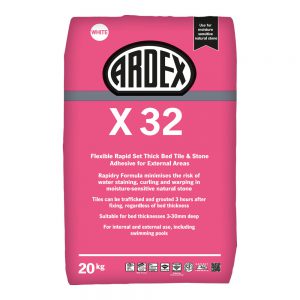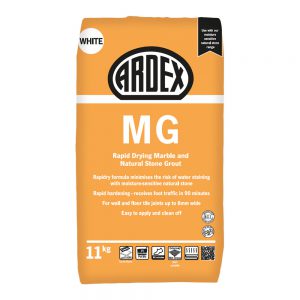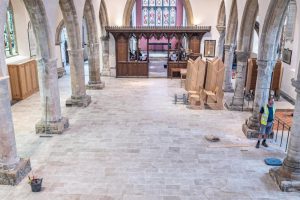Heritage
Projects
St Margaret of Antioch Church
Nestled in the picturesque village of Rottingdean, Sussex, St Margaret of Antioch Church stands as a testament to the enduring spirit of history, heritage and fellowship. This Grade II* Saxon-origin parish church, believed to date back to the early 11th century, has borne witness to centuries of worship and community life. Today, it embarks on a new chapter, thanks to an extraordinary restoration project by GB Tiling Ltd and Parkers and Sons Construction. Their dedication to preserving the past while embracing the future has turned St Margaret’s restoration into a beacon of excellence.
A Journey Through Time
The restoration of St Margaret of Antioch Church is not merely a project; it is a journey through time. The meticulous work began with a comprehensive assessment of the church’s historical fabric and the proposed installation, which required sign-off from esteemed bodies such as the Victorian Society, English Heritage, and the Church of England. This collaborative approach ensured that every step respected the church’s storied past while preparing it for the future – with tile samples and application products and method statements all being sent off for independent assessment before any work could commence.
Archaeological Discoveries
One of the most captivating aspects of the restoration was the unearthing of historical treasures beneath the church’s surface. Archaeologists discovered nine named graves and a crypt with six additional bodies. This remarkable find temporarily halted the project for over two months, allowing experts to carefully excavate, examine, and reinter the remains. This process, complete with blessings by a priest, underscored the team’s commitment to respecting those who found their final resting place in this sacred ground.
Innovations in Preservation
A key highlight of the restoration was the installation of an innovative underfloor heating system by Jupiter Underfloor Heating. Clay pots were placed on top of the original Saxon floor, and underfloor heating panels laid on top before the intricate tiling process began, seamlessly blending ancient architecture with modern comfort.
GB Tiling Ltd installed stunning Jura limestone slabs, ranging from 450x900mm up to 1000x1600mm in size. These natural stone tiles featured beautiful natural details including some prominent fossils and shells.
Installing was extremely labour intensive. Some slabs weighed up to 80kg, requiring immense skill and precision to cut, lift and install. Any breakages or slips could have resulted in the loss of £1000s worth of expensive limestone.
The slabs were fixed with ARDEX X 32 flexible rapid-set thick bed tile & stone adhesive and grouted with ARDEX MG – a specialist flexible rapid-set tile & stone grout to ensure there was no discolouration or staining on the slabs.
The transformation of the church’s flooring is a testament to human ingenuity and craftsmanship, ensuring the floor’s longevity for centuries to come.
Craftsmanship and Collaboration
The success of this restoration hinged on the exceptional craftsmanship of GB Tiling Ltd and collaboration between all parties involved.
A custom-fabricated aisle, bordered and banded through the archway columns, was cut on-site with remarkable attention to detail.
This intricate work not only preserved the church’s historical essence but also enhanced its aesthetic appeal, creating a harmonious blend of old and new.
A Lasting Legacy
As we reflect on the transformation of St Margaret of Antioch Church, it is hard to imagine the journey from the initial site visits in mid-June to the breathtakingly finished floor we see today. This project has given the church with a new luxury it has never experienced before, while ensuring its historical integrity remains intact.
St Margaret’s restoration is a beautiful example of heritage preservation, where history and innovation merge to breathe new life into a cherished village church.
This achievement would not have been possible without the dedication of GB Tiling Ltd and Parkers and Sons Construction and the invaluable contributions of their partners including ARDEX who produced a full specification and assisted with on-site support throughout the process of the build.
Their passion and commitment to this project have ensured that St Margaret of Antioch will continue to stand as a beacon of the village life for generations to come.
In summary, the restoration of St Margaret of Antioch is an exemplary model of heritage tiling and conservation. It exemplifies how respect for the past, coupled with innovative solutions, can revitalise historical sites. This project not only preserves a treasured piece of history but also sets a new standard for heritage tiling with underfloor heating across the UK.
Products used for this project
-

ARDEX X 32
Flexible Rapid Set Thick Bed Tile & Stone Adhesive for External Areas
- Minimises the risk of water staining, curling and warping in moisture-sensitive natural stone
- Up to 30mm bed thicknesses is ideal for fixing uncalibrated stone
-

ARDEX MG
Flexible Rapid Set Tile & Stone Grout
- Minimises the risk of water staining with moisture-sensitive natural stone
- Tiles can be trafficked after 90 minutes














